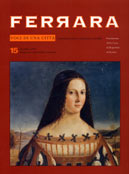He started his concert career at the Bologna School of Music, and at the Teatro Comunale and Teatro Verdi in Ferrara: precociously talented, the bold and informal spirit of his early career was to characterise his whole life. While still very young, Ferraresi performed in the silent film orchestra at the Apollo Cinema in Ferrara, and in the café concerts in Viareggio and Florence. His life ran almost parallel to that of the great Vasa Prihoda. And it was Vasa Prihoda, together with Jan Kubelik, who prompted Ferraresi to go to Brussels to study under the famous Violinist Eugène Ysaye, who later considered him to be the best of all his students (and he had had some famous students: Enescu, Kreisler, Milstein, Thibaud...).
His solo career began brilliantly. Bold technique, emotional intensity, and close family relationships were the dominant aspects of Aldo Ferraresi's life.
Fascism and war weighed heavily on the Ferraresi family especially since Aldo's mother was of Jewish origin. However, the storm passed.
From La Scala in Milan to the Royal Festival Hall in London, Ferraresi performed around the world. He gave concerts in Spain, Germany, Switzerland, Russia, Portugal, Yugoslavia, and the United States, where he was invited to celebrate the anniversary of the founding of the Philadelphia Orchestra. He performed under the most famous conductors: Scherchen, Knappertsbusch, Munch, Barbirolli, Rodzinski, Celibidache, Klecky, Kurz, Cluytens, Poulet, Erede, Rossi, Zecchi, and many others.
After the Second World War, in 1948, Ferraresi returned to the spotlight by performing at the La Scala in Milan. As he performed the incredibly difficult concerto for violin and orchestra by Mario Guarino, under the direction of André Cluytens, the audience watched his steel fingers unfold like silk tissue.
Aldo Ferraresi gave two particularly memorable concerts: one in Genoa in 1950 to celebrate the five hundredth anniversary of the birth of Christopher Columbus, where he performed Paganini's Concerto in D major on the Guarnieri "Cannone" violin; and the second in 1965 when Ferraresi played Jean Sibelius' Solemn Melodies Op. 77 at a concert in the Vatican, in the Hall of Benedictions, in the presence of Pope Paul VI and his Papal Court. No less important, however, was the concert of 1950 in San Remo in the presence of Prince Philip, Duke of Edinburgh, when he gave the Paganini Concerto in D major as an encore.
In 1963, his performance of the Aram Khachaturian concerto for violin and orchestra, conducted by the composer, was televised by the RAI.
Ferraresi never neglected chamber music which he held in great esteem. He played first violin in the San Remo Quartet and the San Remo Symphonic Orchestra, as well as concertmaster at the Teatro San Carlo in Naples.
Among the pianists who accompanied him, we will always remember Antonio Beltrami, Riccardo Castagnone, Ernesto Galdieri, and his own son Augusto Ferraresi. When Efrem Zimbalist died, the Curtis Institute of Philadelphia called on Ferraresi to direct the violin department, but Aldo Ferraresi elected to stay in Italy with his family.
At the end of his life, Aldo Ferraresi moved from Naples to the town of Ospedaletti where his family had lived for many years in a beautiful villa in the surrounding hills. His wish was to be near the final resting place of his mother and brother who were buried in Ospedaletti.
On June 29, 1978 he died of an unexpected and incurable illness in San Remo, the city which had witnessed his rise to success. In Ferrara, a street in the so-called "musicians district" has been named after him.



